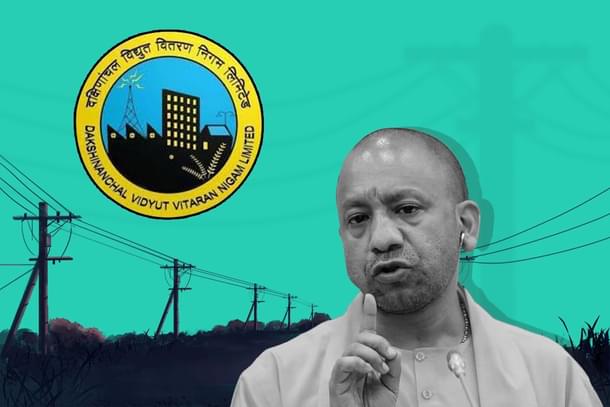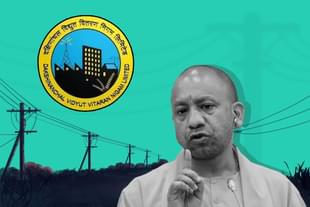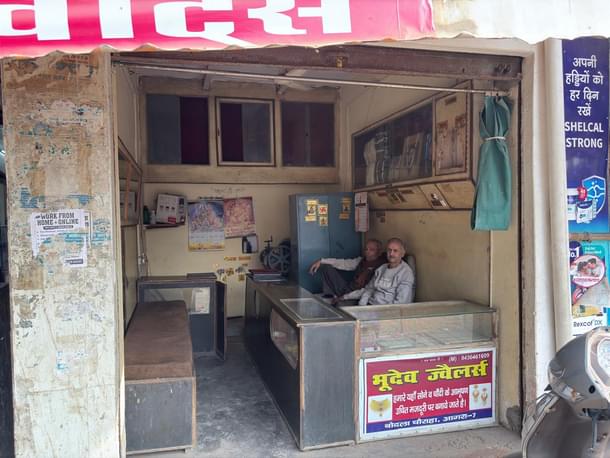Infrastructure
Privatising Power: Yogi Government’s Bold Move To Revive Struggling DISCOMs Faces Engineer Backlash— Ground Report From Agra
Ankit Saxena
Dec 03, 2024, 04:15 PM | Updated Jan 22, 2025, 10:53 AM IST
Save & read from anywhere!
Bookmark stories for easy access on any device or the Swarajya app.


The Uttar Pradesh Power Corporation Limited (UPPCL) recently announced its plans to privatise electricity distribution in the state — in response to the massive financial losses faced by its power distribution companies (DISCOMs).
The proposed strategy focuses on introducing private sector participation in areas experiencing significant fiscal deficits, aiming to revive struggling DISCOMs, which are currently under cumulative losses of Rs 1.1 lakh crore.
As debts continue to escalate, the urgency for privatisation has intensified, however, the initiative has also met resistance from existing DISCOM engineers, who oppose the move.
The idea of privatising has been proposed before many times in the state across governments of different parties.
After several of these unsuccessful attempts over the past decade, the Yogi Adityanath-led government is making a renewed effort through a Public-Private Partnership (PPP) model.
Uttar Pradesh has five government-run DISCOMs under UPPCL —
Paschimanchal Vidyut Vitran Nigam Limited (PVVNL)
Madhyanchal Vidyut Vitran Nigam Limited (MVVNL)
Dakshinanchal Vidyut Vitran Nigam Limited (DVVNL)
Purvanchal Vidyut Vitran Nigam Limited (PuVVNL)
Kanpur Electricity Supply Company Limited (KESCO)
These DISCOMs face challenges like transmission losses and inefficiency. The state has decided to pilot the PPP initiative in Agra and Varanasi — with plans to transfer operations of the PuVVNL (Varanasi) and the DVVNL (Agra) DISCOMs to private entities.
These two companies report the highest financial losses among the state’s DISCOMs.
Historically, most power DISCOMS in various states have faced weak financial strength, power theft, and the absence of any template to improve the operational mechanisms that governed the supply of power.
At the central level, in 2015, the Ujwal DISCOM Assurance Yojana (UDAY) was launched to improve the financial and operational performance of state-owned power distribution companies.
The objectives included reducing Aggregate Technical and Commercial (AT&C) losses to 15 per cent, closing the gap between the Average Cost of Supply (ACS) and Average Revenue Realized (ARR), and ensuring 24x7 power supply.
While UDAY succeeded in lowering interest costs and facilitating states’ takeover of substantial DISCOM debts, it fell short of achieving its operational efficiency targets.
AT&C losses in most states remained around 20 per cent, and the ACS-ARR gap persisted. Additionally, as per reports, it was also highlighted that UDAY was unable to deliver significant financial improvements for many DISCOMs — underscoring the need for deeper reforms and greater accountability.
As per a HT report, in Uttar Pradesh, as of September this financial year, the AT&C losses in the Varanasi DISCOM were 33.48 per cent —the highest among the five state-run DISCOMs—followed by 25.76 per cent in Agra.
In comparison, Meerut, Kanpur and Lucknow reported significantly lower losses of 11.41 per cent, 13.48 per cent, and 18.74 per cent, respectively.
Further, internal UPPCL documents reveal that the Agra and Varanasi DISCOM exhibit the weakest financial performance in other key metrics.
This has been a central factor in the government’s decision to prioritise the privatisation of these two underperforming entities.
Power Distribution in Agra
Until 2010, the distribution of electricity in Agra was fully managed by the DVVNL.
However, as the initial steps toward privatisation began in Uttar Pradesh, the administration of urban power distribution in Agra was handed over to Torrent Power, a private company from Gujarat.
This marked the first time a private player managed power distribution in the state outside the NCR region, where Noida-Greater Noida was already under private administration.
"There has been major change since then. Of course, there were many issues with the supply earlier, which is why Torrent had come," said a resident who has been receiving power through the franchisee distribution.
"There were high-tension wires dangling everywhere, crisscrossing houses, and also frequent power cuts and theft. Over the years, the company has implemented several measures to prevent these issues," the resident added.
Frequent power outages, extended load-shedding lasting up to six hours, transformer failures, and an over-reliance on generators and stabilisers were once commonplace in the region.
Customer service was non-existent. As per residents, with just one centre, people had to wait days, or a week to get their issues resolved.
These challenges still exist in several parts but have largely been mitigated in areas managed by Torrent.
"Transforming the system was no easy task," said Dr. Siraj Qureshi, a veteran journalist and social worker in Agra.
"The company went through many issues, including political hurdles. They began by improving operations and management, dividing Agra city into four zones for better accessibility and control."
One of the major changes was the underground installation of power lines. This step not only reduced maintenance and minimised power theft but lowered the chances of accidents, especially during rains or due to animals.
All these changes, added to the cost, yet residents report improved experience, with minimal power cuts and reliable electricity.
"Yes, the cost is slightly higher, but it is compensated by the quality of service and the time we save”, remarked another resident.
According to the agency, it took nearly a decade for the company to break even after investing heavily in infrastructure development, public interaction, and operational upgrades.
Such a case brings to notice that while revenue and profit are critical to power distribution, other aspects on the ground — such as infrastructure quality, operational efficiency, public issue resolution, accessibility, and customer convenience — are equally crucial.
Many people also added that as Agra has grown, clearing overhead power lines was essential for modernising the city and enhancing its appeal as a tourist destination.
In areas where DVVNL continues to manage power distribution—which is a major portion of the Agra zone extending far beyond the city — the issues still persist.
In the market area of Godhla, home to shops that have operated for 50-60 years, business owners still face frequent power outages.
One shopkeeper, whose business falls under the DVVNL region while his residence is served by the private franchise, tells Swarajya," In the market, power cuts last anywhere from 4 to 6 hours almost daily. But at home, it's completely different.”
“We've forgotten what a power cut feels like. I do not know why other areas are still left out of that system. There are no improvements through the government, or no changes in the supply.”, he added.

Issues Under Government DISCOM
Currently, the private franchise in Agra handles approximately 3 lakh consumers, whereas DVVNL oversees a significantly larger network, serving about 62 lakh consumers.
People say that the government-run board faces many challenges that hinder their ability to function effectively, even after their efforts.
There is too much political interference which stops most of meaningful changes to be implemented.
Further, the government boards are responsible to cater to subsidies intended to reduce costs for farmers, unpaid bills, and poor revenue collection—all of which add to the board's financial losses.
While private companies also face pressure, widespread corruption within government institutions add to the inefficiencies.
“It is not always the department at fault but rather ground-level workers like linemen, who lack accountability”, a power sector employee tells Swarajya.
“This makes it easier for corruption and manipulation, which includes issues like faulty electricity meters or billing discrepancies. There are transactional arrangements on ground which are never accounted for.”
“Whereas, private companies have introduced measures to get these dues cleared, negotiate settlements, and allow customers to modify their usage. The government systems remain rigid”, he adds.
Several industrialists and business owners in Agra feel that private companies are better capable to handle these responsibilities, as they are less entangled in bureaucratic hurdles.
Meanwhile, many continue to blame the inefficiencies and losses on the typical behaviour of government departments.
UPPCL’S Proposed Model To Introduce Private Sector
Under the proposed privatisation model, a public-private partnership (PPP) arrangement will be implemented.
The UPPCL will retain a 49 per cent stake in the new private entities, while the private partners will hold a 51 per cent majority share. UPPCL will also remain responsible for repaying loans taken from state and central governments, banks, and financial institutions.
Several models have been acted on for power distribution partnerships in the past in Uttar Pradesh.
One, Distribution Franchising (DF), where private companies purchase power from the government board and sell it to consumers at regulated rates. These private firms do not generate electricity and focus solely on distribution, which is the case with Torrent Power in Agra city.
Two, Licensee Model, as is set up for Noida Power Company Limited (NPCL) in the Noida zone. This allows private companies to operate independently, managing power procurement, distribution, and related infrastructure, much like government bodies.
Three, is the current proposal where private entities will own 51 per cent equity and utilise their own resources along with existing government infrastructure. This hybrid model is intended to optimise operational efficiency with the use of both public and private capabilities.
As part of this, two new private entities will be created from the existing DISCOMs in Varanasi and Agra.
These new entities will start afresh, free from legacy financial burdens such as loan liabilities, arrears, or other debts.
While the private entities focus on operations, UPPCL, will shoulder the responsibility of managing and repaying existing loans and financial obligations incurred by the state-run DISCOMs.
Lessons from Delhi
In a way, the reforms draw parallels with Delhi’s transformation in 2002-2003, when the Delhi Vidyut Board (DVB) was unbundled and privatised amidst opposition.
Three new DISCOMs were created, with private companies acquiring a 51 per cent stake while the government retained 49 per cent.
The decision then, has yielded bold results today, with Delhi having one of the most modern distribution networks, supporting a surge in power demand from 2,879 MW in 2002 to over 7,400 MW — a 250 per cent increase
But The Power Engineers Are Angry
Power engineers in the state have raised strong objections to the proposed plan for Varanasi and Agra Electricity Distribution Corporations.
The engineers argue that privatisation is being justified on the grounds of financial losses, which they contend have been misrepresented by the power corporation.
Prabhat Singh, executive engineer at DVVNL, tells Swarajya, “The management has been misleading by citing financial difficulties while overlooking the contributions of engineers in operational improvements.”
The engineers’ primary concern lies in the potential job losses that privatisation could bring. “It is estimated that around 27,600 employees across both corporations, including 1,523 engineering positions, could face redundancy”, he adds.
“The state is comparing the privatisation model adopted in Odisha, where electricity rates rose to Rs 14 per unit. However, there are differences between Odisha and UP, that make such a model unsuitable for their state.”
“Agricultural consumption, for instance, constitutes only 5-6 per cent of total power use in Odisha but accounts for 30-40 per cent in UP. Further, it is heavily subsidised, with farmers receiving electricity at Rs 3 per unit despite the board purchasing it at Rs 4.35 per unit.”
"What are the plans to cater to these distributions? Many worry that privatisation could disrupt this subsidy structure, affecting the farming community”, the engineers add.
The engineers also added the risks associated with privatisation, with examples from other states where privatised DISCOMs failed to bear losses caused by natural disasters.
“In one such case, the company exited operations, leading to losses of provident funds and financial hardships for employees”, Prabhat added.
Moreover, the employees continued to express frustration over being blamed for the financial losses and inefficiencies of DISCOMs.
For them, schemes like UDAY and RDSS (Revamped Distribution Sector Scheme), along with government investments in infrastructure, have gradually improved operations.
Reports from the Power Corporation reveal that total financial losses amount to Rs 1.10 lakh crore, while outstanding electricity bill arrears from consumers reached Rs 1.15 lakh crore in the fiscal year 2023-24.
However, according to Prabhat, “clearing government arrears and granting operational authority to the engineers’ body for better management, will show positive results within two years.”

A Balancing Act
As per recent developments, considering such issues and more, the power corporation’s revised focuse is on balanced privatisation and addressing long-standing inefficiencies in the system.
Under the new model, PuVVNL will be divided into three companies, and DVVNL into two which makes each company cater to nearly 30 to 35 lakh consumers — of both rural and urban areas.
As per reports, by allocating both areas, the reform ensures equitable service delivery across regions, breaking the practice of cherry-picking profitable zones by private players.
Further, it will also focus on protecting the interests of existing employees — provisions for service conditions, salaries, promotions, and retirement benefits will be formalised in agreements to safeguard their welfare.
Employees will have three options — remain in their current positions, transition to a new company, or opt for voluntary retirement. However, employee unions and engineers remain skeptical, especially about the effectiveness of voluntary retirement schemes.
Ultimately, the UPPCL's proposed model seeks to strike a balance between public and private interests — with the government retaining a 49 per cent stake, ensuring oversight and accountability, while private companies bring in efficiency and investment.
Moreover, for the Yogi Adityanath-led government, the timing of these reforms is critical, with the next state elections approaching in another two years. Cutting public sector losses is a crucial political objective, and reducing financial burdens through privatisation comes as a vital step toward addressing the state’s financial deficit in power distribution.





